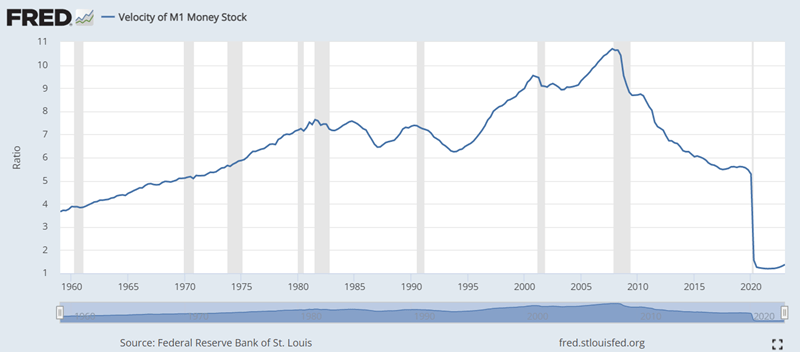
The velocity of money refers to the rate at which money circulates through the economy. It’s chiefly determined by how fast transactions occur. For financial traders, identifying the velocity of money and what’s propelling it can help you to analyse markets and identify trading opportunities.
Understanding the velocity of money
The velocity of money represents the number of times a unit of currency changes hands within a specific time frame. It is used to measure economic activity and can be calculated by dividing the nominal gross domestic product (GDP) by the money supply.
Velocity of money formula:
Velocity of money = GDP / money supply
A high velocity of money means that currency is being used frequently for transactions, suggesting a vibrant and thriving economy. A low velocity indicates an economy where money is stagnant and transactions infrequent. The velocity of money doesn’t explain people’s spending habits, it only measures them.
However, there are prevailing theories as to why velocity may slow or increase.
- In low-velocity economies people might hold their money because they don’t have faith in financial institutions or new supplies have slowed.
- In high-velocity economies, prices could be rising, and people are required to spend more. On the other hand, people could spend more if prices are low, unemployment is down, or any other economic figure is encouraging money to circulate more often
How the velocity of money impacts traders
The velocity of money impacts traders by directly influencing market dynamics and trading strategies. A high velocity of money implies increased liquidity and higher transaction volumes. High liquidity means there is a larger number of buy and sell orders in the market. While this may tighten the bid-ask spread, it also means there will be more and faster market movements to base trades on.
Low-velocity markets on the other hand experience reduced liquidity and lower trading volumes. In this scenario, the bid-ask spread widens and it can become difficult to open and close positions at your desired price.
A lower velocity of money may also influence you to change trading strategies. With wide spreads, quick strategies like day trading or swing trading become harder to execute successfully. Traders may switch to a longer-term strategy or refocus on more liquid markets altogether.
Understanding the velocity of money can help you anticipate potential shifts in market sentiment to adjust your strategy appropriately.
Trade currencies on the forex market
You can practise trading foreign exchange with a City Index account. Log in or open an account to get started. You can also learn more about forex in our Trading Academy. To start trading, follow these steps:
- Open an account or log in if you’re already a customer
- Search for the market you want to trade in our award-winning platform
- Choose your position and size, and your stop and limit levels
- Place your trade
Alternatively, you can open a demo account to practice trading forex and hundreds of other markets with City Index.
How central banks affect the velocity of money
Central banks often pass policies that affect the velocity of money by increasing or decreasing the money supply. One reason for this is the link between an economy’s velocity and its level of inflation.
The greater the supply of money, the more likely an economy’s velocity is to increase and for prices to rise. When money is tight or central banks slow the money supply, people are more likely to hold onto their cash and the velocity of money decreases.
Traders can analyse this relationship and use the current velocity of money to measure how successful central bank policy is. By monitoring changes in the velocity of money, you can gauge the impact of interest rate adjustments, quantitative easing measures, or other policy interventions on the overall economy and financial markets. Such insights enable you to adjust your positions ahead of economic changes or hedge against potential risks.
Other factors that influence the velocity of money
There are several factors that can signal whether an economy’s velocity will speed up or slow down. Macroeconomic indicators such as GDP growth, inflation rates, consumer spending and monetary policy decisions can help identify trends in monetary velocity.
Any of these components can help you measure the velocity of money for an economy, both the current and expected rate. Traders should pay attention to the latest publications of these indicators and factor them into decisions when attempting to anticipate market movements.
Velocity of money example
To give an example of calculating the velocity of money, let’s imagine a small economy in which the nominal GDP is €1,000,000 and the money supply is €200,000.
Now plug these two numbers into the velocity of money formula: 1,000,000 / 200,000 = 5
In this economy, the velocity of money is 5. On average each dollar cycles through the economy five times in a given period (in this case one year).
Velocity of money in the real world
In the US, the velocity of money has been in decline ever since the 2008 financial crash. Before then, the velocity of the US economy typically only fell during and immediately after a recession as indicated by the shaded columns on the chart below. However, since 2008 the velocity of the M1 supply has steadily fallen. M1 is a measure of the money supply that includes only circulated currency and checkable deposits.
Economists have attributed the decline to a generational shift. Baby boomers are in retirement and household wealth has generally reduced across the board. Newer generations have more incentive to save, and so do banks with the introduction of the Dodd-Frank Act increasing reserve requirements.











